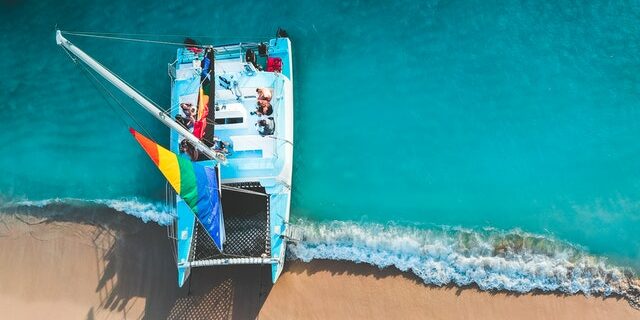Catamarans use trampolines for multiple reasons. Trampolines are lightweight, offer low wind and water resistance, and provide a comfortable area for passengers. These characteristics make trampolines ideal for optimizing both performance and usability on catamarans.
Key Functions of Trampolines on Different Catamaran Types
The functions of trampolines vary based on the type of catamaran. Here’s how trampolines are used across different vessels:
- Racing Catamarans (Day Cruisers): Trampolines serve as the main seating and lounging platform.
- Livable Catamarans: Trampolines are typically located at the front, expanding deck space.
- Power Catamarans: These usually do not have trampolines due to their design and purpose.
Benefits of Catamaran Trampolines
- Lightweight Material
Trampolines are made from mesh materials like polyester, polypropylene, or polyamide. This significantly reduces the overall weight of the boat, enhancing speed and performance. - Immediate Drainage
The mesh design allows water to drain off quickly, making it ideal for the nose of the catamaran, which often faces splashing waves. - Low Wind Resistance
The mesh has almost no wind resistance, minimizing drag and helping the catamaran maintain speed, especially in windy conditions. - Expanded Deck Area
By connecting the two hulls with a trampoline, catamarans gain extra usable space at the front, enhancing both functionality and comfort without sacrificing performance. - Comfortable Living Space
The trampoline offers a comfortable area where passengers can relax, similar to a hammock. It provides excellent support as the boat moves with the waves, making it a favored spot for lounging. - Aesthetic Appeal
Trampolines contribute to the sleek, modern look of catamarans, adding to their visual appeal while maintaining functionality.
Materials Used in Catamaran Trampolines
Catamaran trampolines are usually made from one of the following materials:
- Polyester: Known for durability and strength.
- Polypropylene: A lightweight and water-resistant option.
- Polyamide: Offers high flexibility and resistance to wear.
- Dyneema: A high-strength option used in performance-based catamarans.
Some day-cruiser racing catamarans use vinyl-type trampolines, which are less permeable to wind and water but are commonly used in smaller vessels.
How Safe Are Catamaran Trampolines?
Catamaran trampolines are generally very safe. The material is strong and durable. However, the weakest point often lies in how the trampoline is secured to the boat. It’s recommended to secure each ring individually to maximize safety and prevent failures.
How Are Trampolines Installed on a Catamaran?
The installation process varies by catamaran model. Generally, trampolines are secured with lines or threaded onto rings around the boat’s frame. For specific installation instructions, refer to guides tailored to your boat model, or consider professional installation services.
Can You Install a New Trampoline Yourself?
Yes, installing a new trampoline is a DIY-friendly task for many catamaran owners. For a thorough guide, watch this video on how to renew trampolines on a 2003 Antares catamaran.
Summary of Trampoline Benefits
- Lightweight: Minimizes overall boat weight for better performance.
- Quick drainage: Keeps the boat dry in rough seas.
- Low wind resistance: Enhances speed by reducing drag.
- Expanded deck space: Offers more usable area at the front.
- Comfortable: A perfect space for lounging and relaxing.
Conclusion
Catamaran trampolines are an integral part of the boat’s design, serving practical, performance-enhancing, and aesthetic purposes. By reducing weight, improving comfort, and expanding deck space, they enhance the overall sailing experience.



